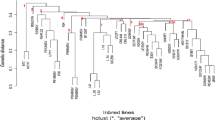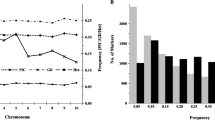Abstract
Key message
The potential for exploiting heterosis for sorghum hybrid production in Ethiopia with improved local adaptation and farmers preferences has been investigated and populations suitable for initial hybrid development have been identified.
Abstract
Hybrids in sorghum have demonstrated increased productivity and stability of performance in the developed world. In Ethiopia, the uptake of hybrid sorghum has been limited to date, primarily due to poor adaptation and absence of farmer’s preferred traits in existing hybrids. This study aimed to identify complementary parental pools to develop locally adapted hybrids, through an analysis of whole genome variability of 184 locally adapted genotypes and introduced hybrid parents (R and B). Genetic variability was assessed using genetic distance, model-based STRUCTURE analysis and pair-wise comparison of groups. We observed a high degree of genetic similarity between the Ethiopian improved inbred genotypes and a subset of landraces adapted to lowland agro-ecology with the introduced R lines. This coupled with the genetic differentiation from existing B lines, indicated that these locally adapted genotype groups are expected to have similar patterns of heterotic expression as observed between introduced R and B line pools. Additionally, the hybrids derived from these locally adapted genotypes will have the benefit of containing farmers preferred traits. The groups most divergent from introduced B lines were the Ethiopian landraces adapted to highland and intermediate agro-ecologies and a subset of lowland-adapted genotypes, indicating the potential for increased heterotic response of their hybrids. However, these groups were also differentiated from the R lines, and hence are different from the existing complementary heterotic pools. This suggests that although these groups could provide highly divergent parental pools, further research is required to investigate the extent of heterosis and their hybrid performance.





Similar content being viewed by others
References
Ahnert D, Lee M, Austin DF, Livini C, Woodman WL, Openshaw SJ, Smith JSC, Porter K, Dalton G (1996) Genetic diversity among elite sorghum inbred lines assessed with DNA. Crop Sci 36:1385–1392
Anderson JA, Churchill GA, Autrique JE, Tanksley SD, Sorrels ME (1993) Optimizing parental selection for genetic linkage maps. Genome 36:181–186
Ayana A, Bryngelsson T, Bekele E (2000) Genetic variation of Ethiopian and Eritrean sorghum (Sorghum bicolor L. Moench) germplasm assessed by random amplified polymorphic DNA (RAPD). Genet Resour Crop Ev 47:471–482
Ben-Israel I, Kilian B, Nida H, Fridman E (2012) Heterotic Trait Locus (HTL) mapping identifies intra-locus interactions that underlie reproductive hybrid vigour in Sorghum bicolor. PLoS One 7:6
Betrân FJ, Ribaut JM, Beck D, Gonzalez de León D (2003) Genetic diversity, specific combining ability and heterosis in tropical maize under stress and non-stress environments. Crop Sci 43:797–806
Brown JP, Myles S, Kresovich S (2011) Genetic support for phenotype based racial classification in sorghum. Crop Sci 51:224–230
Casa AM, Pressoir G, Brown PJ, Mitchell SE, Rooney WL, Tuinstra MR, Frank CD, Kresovich S (2008) Community resources and strategies for association mapping in sorghum. Crop Sci 48:30–40
Cavatassi R, Lipper L, Narloch U (2011) Modern variety adoption and risk management in drought prone areas: insights from the sorghum farmers of eastern Ethiopia. Agr Econ 42:279–292
Crow JF (1998) Anecdotal, historical and critical commentaries on genetics. Genetics 148:923–928
Darvishzadeh R (2012) Phenotypic and molecular marker distance as a tool for prediction of and heterosis and F1 performance in sunflower (Helianthus annus L.) under well-watered and water stressed conditions. Aust J Crop Sci 6:732–738
Desmae H (2007) Genetic diversity and variability in grain quality of sorghum (Sorghum bicolor L. Moench) landraces from North–Eastern Ethiopia. PhD thesis. University of Queensland
Deu M, Rattunde F, Chantereau J (2006) A global view of genetic diversity in cultivated sorghum using a core collection. Genome 49:168–180
Duvick DN (1999) Heterosis: Feeding people and protecting natural resources. In: Coors JG, Pandey S (eds) The genetics and exploitation of heterosis in Crops. Madison, Wisconsin, USA, pp 19–29
Evanno G, Regnaut S, Goudet J (2005) Detecting the number of clusters of individuals using the software STRUCTURE: a simulation study. Mol Ecol 14:2611–2620
Excoffier LGS, Schneider S (2005) Arlequin ver. 3.0 An integrated software package for population genetics data analysis. Evol Bioinform Online 1:47–50
Falush D, Stephens M, Pritchard JK (2003) Inference in population structure using multi-locus genotype data: linked loci and correlated allele frequencies. Genetics 164:1567–1587
Gabriel K (2005) A study of heterotic relationships in sorghum. PhD Thesis. Texas A & M University
Ganapathy KN, Gomash SS, Rakshit S, Ambekar SS, Ghorade RB, Birdar BD, Saxena U, Patil JV (2012) Genetic diversity reveals utility of SSR markers in classifying parental lines and elite genotypes of sorghum (Sorghum bicolor L. Moench). Aust J Crop Sci 6:1486–1493
Gebrekidan B (1980) Breeding and yield evaluation of hybrid sorghum and its production prospects in Ethiopia. Ethiopian J Agri Sci 2:101–114
Geleta N, Labuschagne MT, Viljoen C (2006) Genetic diversity analysis in sorghum germplasm as estimated by AFLP, SSR and morpho agronomical markers. Biodivers Conserv 15:3251–3265
Haussmann BIG, Obilana AB, Blum A, Ayiecho PO, Schipprack W, Geiger HH (1998) Hybrid performance of sorghum and its relationship to morphological and physiological traits under variable drought stress in Kenya. Plant Breed 117:223–229
Jordan DR, Tao Y, Godwin ID, Henzell RG (2003) Prediction of hybrid performance in grain sorghum using RFLP markers. Theor Appl Genet 106:559–567
Jordan DR, Mace ES, Henzell PE, Klein RR (2010) Molecular mapping and candidate gene identification of the Rf2 gene for pollen fertility restoration in sorghum (Sorghum bicolor L. Moench). Theor Appl Genet 120:1279–1287
Jordan DR, Klein RR, Sakrewski KG, Henzell RG, Klein PE, Mace ES (2011) Mapping and characterization of RF 5 a new gene conditioning pollen fertility restoration in A1 and A2 cytoplasm in sorghum (Sorghum bicolor L. Moench). Theor Appl Genet 123:383–396
Klein RR, Klein PE, Mullet JE, Minx P, Rooney WL, Schertz KF (2005) Fertility restorer locus Rf1 of sorghum (Sorghum bicolor L. Moench) encodes a pentatricopeptide repeat protein not present in the collinear region of rice chromosome 12. Theor Appl Genet 111:994–1012
Larièpe A, Mangin B, Jasson S, Combes V, Dumas F, Jamin P, Lariagon C, Jolivot D, Madur D, Fievet J, Gallais A, Gubreuil P, Charcosset A, Moreau L (2012) The genetic basis of heterosis: multi parental quantitative trait loci mapping reveals contrasted level of apparent over dominance among traits of agronomic interest in maize (Zea mays L.). Genetics 190:795–811
Lee EA, Ash MJ, Good B (2007) Re-examining the relationship between degree of relatedness, genetic effects and heterosis in Maize. Crop Sci 47:629–635
Mace ES, Jordan DR (2011) Integrating sorghum whole genome sequence information with a compendium of sorghum QTL studies reveals uneven distribution of QTL and gene-rich regions with significant implications for crop improvement. Theor Appl Genet 123:169–191
Mace ES, Tai S, Gilding EK, Li Y, Prentis P, Bian L, Campbell B, Hu W, Innes DJ, Han X et al (2013) Whole-genome sequencing reveals untapped genetic potential in African’s indigenous cereal crop sorghum. Nat Commun 4:2320
Mekbib F (2006) Farmer and formal breeding of sorghum (Sorghum bicolor (L.) Moench) and the implications for integrated plant breeding. Euphytica 152:163–176
Menz MA, Klein RR, Unruh NC, Rooney WL, Klein PE, Mullet JE (2004) Genetic diversity of public inbred of sorghum determined by mapped AFLP and SSR markers. Crop Sci 44:1236–1244
Miller JF (1999) Oilseeds and heterosis. In: Coors JG, Pandey S (eds) The genetics and exploitation of heterosis in Crops. Madison, Wisconsin, pp 399–404
Morris GP, Ramu P, Deshpande SP, Hash CT, Shah T, Upadhyaya HD, Kresovich S (2013) Population genomic and genome-wide association studies of agro climatic traits in sorghum. Proc Natl Acad Sci 110:453–458
Parentoni SN, Magalahȃes JV, Pacheco CAP, Santos MX, Abadie T, Gama EEG, Guimarȃes PEO, Merelles WF, Lopes MA, Vsconcelos MJV, Paiva E (2001) Heterotic groups based on yield-specific combining ability data and phylogenetic relationship determined by RAPD markers for 28 tropical maize open pollinated varieties. Euphytica 121:197–208
Paterson AH et al (2009) The Sorghum bicolor genome and the diversification of grasses. Nature 457:551–556
Perrier X, Floria A, Bonnet F (2003) Data analysis methods. In: Hamon P, Sequin, Perrier M, Glaszmann JC (eds) Genetic diversity of cultivated tropical plants. Enfield, Science Publishers. Montpellier, pp 43–76
Perumal R, Krishnaramanujam R, Menz MA, Katilé S, Dahlberg J, Magill CW, Rooney WL (2007) Genetic diversity among sorghum races an working groups based on AFLPs and SSRs. Crop Sci 47:1375–1383
Pritchard JK, Stephens M, Donnelly P (2000) Inference of population structure using multi locus genotype data. Genetics 155:945–959
Qi X, Kimati J, Li Z, Jiang L, Cui Y, Liu B (2010) Heterosis analysis using AFLP markers revealed moderate correlations between specific combing ability and genetic distance in maize inbred lines. Afr J Biot 9:1568–1572
Quinby JR, Karper RE (1954) Inheritance of height in sorghum. Agron J 46:211–216
Ramu P, Billot C, Rami JF, Senthilvel S, Updahyaya HD, Reddy LA, Hash CT (2013) Assessment of genetic diversity in the sorghum reference using EST-SSR markers. Theor Appl Genet 126:2051–2064
Rao SP, Reddy BVS, Nagaraj N, Upadhyaya HD (2014) Sorghum production for diversified uses. In: Wang YH, Upadhyaya HD, Kole C (eds) Genetics, genomics and breeding of Sorghum. CRC Press, FL, pp 1–27
Reddy VG, Upadhyaya HD, Gowda CLL (2006) Current status of sorghum genetic resources at ICRISAT: their sharing and impacts. Int Sorghum Millets Newsl 47:9–13
Reif JC, Hallauer AR, Melchinger AE (2005) Heterosis and heterotic pattern in maize. Maydica 50:215–223
Sokal RR, Michener CD (1958) A statistical method for evaluating system relationship. University of Kansas. Science Bulletin. pp 1409–1438
Stephens JC, Holland RF (1954) Cytoplasmic male sterility for hybrid seed sorghum production. Agron J 46:20–23
Thiemann A, Meyer S, Scholten S (2009) Heterosis in plants: manifestation in early seed development and prediction approaches to assist hybrid breeding. Chinese Sci Bull 54:2363–2375
Thiemann A, Fu J, Seifert F, Grant-Downton RT, Schrag TA, Pospisil H, Scholten S (2014) Genome-wide meta-analysis of maize heterosis reveals the potential role of additive gene expression at pericentromeric loci. BMC Plant Biol 14:88
Van Inghelandt D, Melchinger AE, Lebreton Stich B (2010) Population structure and genetic diversity in a commercial maize breeding program assessed with SSR and SNP markers. Theor Appl Genet 120:1289–1299
Windhausen VS, Atlin GN, Hickey JM, Crossa J, Jannink JL, Sorrells ME, Melchinger AE et al (2012) Effectiveness of genomic prediction of maize hybrid performance in different breeding populations and environments. G3• Genes/Genome/Genetics 2:1427–1436
Acknowledgments
The authors are thankful to AusAID (Australian Agency for International Development) for the financial support to undertake this research and sponsoring PhD scholarship to TTM and QAAFI (Queensland Alliance for Agriculture and Food Innovation) for research support.
Conflict of interest
The authors declare that they have no conflict of interest.
Author information
Authors and Affiliations
Corresponding author
Additional information
Communicated by H.-C. Jing.
Electronic supplementary material
Below is the link to the electronic supplementary material.
122_2015_2545_MOESM1_ESM.doc
Supplementary material 1: Expected Heterozygosity (EH) values of sorghum genotypes using SNPs located in the euchromatin and heterochromatin of each of the chromosome for the three main groups i. Ethiopian improved inbred lines; ii. Introduced inbred lines; iii. Ethiopian landraces genotypes. (DOC 638 kb)
122_2015_2545_MOESM2_ESM.doc
Supplementary material 2: Model based estimation of population structure for (K=2 to 5) for the inbred lines identified as follows: introduction B lines (B), introduced R lines (R); Ethiopian improved lowland (IL) and improved intermediate (IM); Ethiopian landrace highland (LH), intermediate (LI) and lowland (LLG1 and LLG2) genotypes. Each group is separated by a black vertical line. (DOC 254 kb)
122_2015_2545_MOESM3_ESM.pdf
Supplementary material 3: List of sorghum genotypes obtained from Ethiopian landraces, Ethiopian improved and introduced genotypes grouped based on agro-ecological adaptation and fertility response in hybrid breeding. (PDF 147 kb)
Rights and permissions
About this article
Cite this article
Mindaye, T.T., Mace, E.S., Godwin, I.D. et al. Genetic differentiation analysis for the identification of complementary parental pools for sorghum hybrid breeding in Ethiopia. Theor Appl Genet 128, 1765–1775 (2015). https://doi.org/10.1007/s00122-015-2545-6
Received:
Accepted:
Published:
Issue Date:
DOI: https://doi.org/10.1007/s00122-015-2545-6




